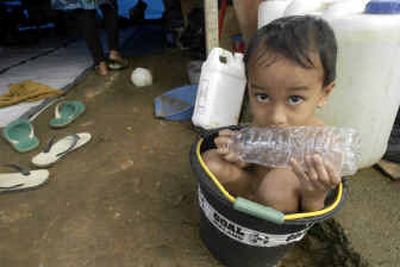Tsunami survivors wait in limbo, shabby shelters

CUDDALORE, India – The floor is dirt, the walls corrugated cardboard. There are no windows, there is no door. There is a foot-high gap between the roof and the walls, a wishful invitation to the slight breeze that sometimes blows from the sea in this hot and destroyed village.
This is the new home of Ezhilarasi, built by the Indian government to replace her stone house with its refrigerator and television and sewing machine. Without the machine, she cannot work. Even if it had survived, it would do her no good.
There is no electricity here.
Only row after row of cardboard lean-tos, dipped in tar to keep out the rain. The government has said it allotted 50,000 rupees (about $1,100) for each dwelling, but that sum is not evident in the crude construction of these shacks. These are what Indian authorities call temporary shelters, refuge designed to house survivors of December’s devastating tsunami for at least three months, while permanent houses are built.
In Ezhilarasi’s fishing village, 57 people perished in the waves, most of them women and children who could not outrun the saltwater. Along with their homes, the sea sucked away their boats and their nets, leaving them with nothing to live in and no way to work.
Now there are 1,450 survivors living in the sand and dirt, waiting to find out what will happen to them. The deliveries of rice and cooking pots from the government and aid organizations have stopped, and food is running out. Like thousands of others along this southern coast of India, these villagers are in limbo, neither here nor there on the long road to recovery.
“How can I like it here?” Ezhilarasi asks. “By noon, it’s too hot to sit in that place,” she says, pointing to the dark brown structure she is supposed to live in. “My children refuse to sleep there. They say the smell of the tar is too awful.”
Her three children, ages 9, 7 and 4, are staying in downtown Cuddalore, with her mother. At night Ezhilarasi and her husband stay there, too. In the morning, her husband walks down to the water and waits for government workers so he can complete a seemingly never-ending series of forms documenting the loss of his home and his boat and his nets. Without such documentation, the family cannot continue to receive aid.
Ezhilarasi walks down to the temporary shelters, and sits with other women from the village, waiting for whatever deliveries of food and clothing will come. The government’s initial payout of 4,000 rupees ($88) and 50 kilos of rice per survivor will not last for long.
“Everything is running out,” the mother says. “We have to feed our children. I’m not sure what I should do. I can go hungry for two days, but what about the children?”
The government has pledged millions to help rebuild. In India, nearly 11,000 drowned in the waves. But how that money will be spent, and where it will go, is still being decided by authorities, leaving those left behind fretting and complaining that the pace of government aid has fallen far behind their needs.
On Dec. 26, the men in this village were far out to sea, fishing in deep waters for mackerel, oblivious to the towering waves approaching their beaches. Those on shore watched the water begin to swell and turn black. “It looked like it had been boiled,” Ezhilarasi says.
And then they started to run. “The water is coming, the water is coming,” they screamed. B. Paramthaman, 42, was one of those fishing. “We felt nothing,” he said. Eight hours later, when the men returned home, “everything was gone,” he said.
Paramthaman has a master’s degree in history from Annamalai University in Chidambaram. He tried to get a bureaucrat’s job in the government, a highly sought-after occupation because of its pay and its security, but he was turned down.
So he returned to fishing, the livelihood of his relatives before him. “We were always comfortable in the water,” he says. “We would rather be out to sea than on land. But now we are frightened by it.”
In Nagappatinam, about three hours south of Cuddalore, a young mother named Farada stands in the doorway of her tarred, one-room shelter in a camp of 350 Muslim families. She balances 11-month-old Mohammed Yousef on her hip, a quiet boy with a serious countenance. Her eyes are dazed.
She has lost her 4-year-old daughter, Yasmeen, and she is inconsolable. “She was the only person I couldn’t save,” she says and begins to weep. “I was holding her when the waves came and took her away from me.”
Her husband works at a mosque. Farada is alone with her son. All they possessed is gone. In their dark, stifling new home, a single bulb hangs from the ceiling. At 6 p.m., she says, the electricity will come on for a few hours, and then go away.
She is asked what she will do now, and how her family will replace their home. “How can I go on without my child?” she says dully. “Only the government can rebuild my house.”
In Cuddalore, Ezhilarasi is joined by a half-dozen other wives who sit on two woven mats they found floating in a nearby river. “This is all that’s left of what we had,” Ezhilarasi says.
Down the dirt path are six toilets for women, and six toilets for men. Each is a thatched cubicle with a bucket. Water comes from spigots dotting the camp, carried home in pots balanced on the women’s heads.
It is quiet here, save for the sound of the hammers, and the women talk of their children and of their boatless husbands.
And of this place where they find themselves, in the anteroom of recovery.
“All I can do is just come here and wait,” says Ezhilarasi, and the women nod their assent.